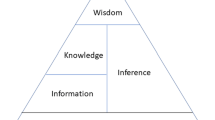Abstract
This paper argues that AI is best defined in terms of its implicit goal—the creation of thinking beings by means other than biological reproduction. Thus AI can be seen as a devious and sophisticated form of birth control. A discussion of the prospects for AI research from this viewpoint follows. It is concluded that the total extermination of the human species would be a better test of whether AI has succeeded than Turing's celebrated ‘imitation game’.
Similar content being viewed by others
Explore related subjects
Discover the latest articles, news and stories from top researchers in related subjects.References
Berry, A. (1983) The Super-Intelligent Machine John Cape, London, UK.
Boden, M. (1987) Artificial Intelligence and Natural Man MIT Press, MA, USA.
Bolter, J. D. (1986) Turing's Man: Western Culture in the Computer Age Penguin, Middx, UK.
Colby, K. (1976) On the Morality of Computers Providing Psychotherapy UCLA Memo AI HMF-6, Los Angeles, USA.
Colby, K., Weber, S. & Hilf, F. D. (1971) Artificial paranoia, Artificial Intelligence 2, 1–25.
Dreyfus, H. & Dreyfus, S. (1985) Mind Over Machine Macmillan, NY, USA.
Ennals, R. (1986) Star Wars: A Question of Initiative John Wiley, Chichester, UK.
Forsyth, R. & Naylor, C. (1985) The Hitch-Hiker's Guide to Artificial Intelligence Chapman & Hall, London, UK.
Forsyth, R. & Rada, R. (1986) Machine Learning: Applications in Expert Systems and Information Retrieval Ellis Horwood, Chichester, UK.
Halpern, M. (1987) Turing's test and the ideology of artificial intelligence. Artificial Intelligence Review 1, 79–93.
Koestler, A. (1964) The Sleepwalkers Penguin, Middx, UK.
Langley, P., Simon, H. A. & Bradshaw, G. L. (1983) Rediscovering chemistry with the BACON system. In Machine Learning: an AI Approach Vol. 1. (eds R.Michalski, J.Carbonell & T.Mitchell) Tioga Press, CA, USA.
Lenat, D. (1982) The nature of heuristics. Artificial Intelligence, 19.
McCorduck, P. (1979) Machines Who Think W.H. Freeman, San Francisco, USA.
Moody, G. (1986) Book review. Practical Computing 9, 12.
Taylor, R. H. (1976) Letter. Datamation, June issue; 35–36.
Turing, A. (1950) Computing machinery and intelligence. Mind, 59, 236–250.
Weizenbaum, J. (1967) Contextual understanding by computers. Communications of the ACM, 10.
Weizenbaum, J. (1984) Computer Power and Human Reason, 2nd edn, Penguin, Middx, UK, 474–481.
Yazdani, M. & Narayanan, A. (1984) Artificial Intelligence: Human Effects Ellis Horwood, Chichester, UK.
Author information
Authors and Affiliations
Rights and permissions
About this article
Cite this article
Forsyth, R. The trouble with AI. Artif Intell Rev 2, 67–77 (1988). https://doi.org/10.1007/BF00139626
Issue Date:
DOI: https://doi.org/10.1007/BF00139626



